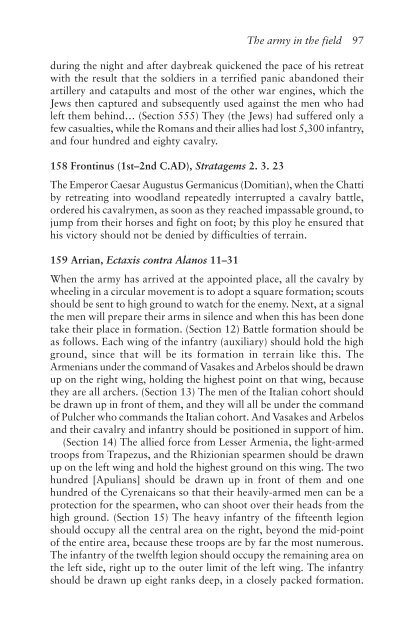The Roman Army, 31 BC–AD 337: A Sourcebook
The Roman Army, 31 BC–AD 337: A Sourcebook
The Roman Army, 31 BC–AD 337: A Sourcebook
You also want an ePaper? Increase the reach of your titles
YUMPU automatically turns print PDFs into web optimized ePapers that Google loves.
<strong>The</strong> army in the field 97<br />
during the night and after daybreak quickened the pace of his retreat<br />
with the result that the soldiers in a terrified panic abandoned their<br />
artillery and catapults and most of the other war engines, which the<br />
Jews then captured and subsequently used against the men who had<br />
left them behind… (Section 555) <strong>The</strong>y (the Jews) had suffered only a<br />
few casualties, while the <strong>Roman</strong>s and their allies had lost 5,300 infantry,<br />
and four hundred and eighty cavalry.<br />
158 Frontinus (1st–2nd C.AD), Stratagems 2. 3. 23<br />
<strong>The</strong> Emperor Caesar Augustus Germanicus (Domitian), when the Chatti<br />
by retreating into woodland repeatedly interrupted a cavalry battle,<br />
ordered his cavalrymen, as soon as they reached impassable ground, to<br />
jump from their horses and fight on foot; by this ploy he ensured that<br />
his victory should not be denied by difficulties of terrain.<br />
159 Arrian, Ectaxis contra Alanos 11–<strong>31</strong><br />
When the army has arrived at the appointed place, all the cavalry by<br />
wheeling in a circular movement is to adopt a square formation; scouts<br />
should be sent to high ground to watch for the enemy. Next, at a signal<br />
the men will prepare their arms in silence and when this has been done<br />
take their place in formation. (Section 12) Battle formation should be<br />
as follows. Each wing of the infantry (auxiliary) should hold the high<br />
ground, since that will be its formation in terrain like this. <strong>The</strong><br />
Armenians under the command of Vasakes and Arbelos should be drawn<br />
up on the right wing, holding the highest point on that wing, because<br />
they are all archers. (Section 13) <strong>The</strong> men of the Italian cohort should<br />
be drawn up in front of them, and they will all be under the command<br />
of Pulcher who commands the Italian cohort. And Vasakes and Arbelos<br />
and their cavalry and infantry should be positioned in support of him.<br />
(Section 14) <strong>The</strong> allied force from Lesser Armenia, the light-armed<br />
troops from Trapezus, and the Rhizionian spearmen should be drawn<br />
up on the left wing and hold the highest ground on this wing. <strong>The</strong> two<br />
hundred [Apulians] should be drawn up in front of them and one<br />
hundred of the Cyrenaicans so that their heavily-armed men can be a<br />
protection for the spearmen, who can shoot over their heads from the<br />
high ground. (Section 15) <strong>The</strong> heavy infantry of the fifteenth legion<br />
should occupy all the central area on the right, beyond the mid-point<br />
of the entire area, because these troops are by far the most numerous.<br />
<strong>The</strong> infantry of the twelfth legion should occupy the remaining area on<br />
the left side, right up to the outer limit of the left wing. <strong>The</strong> infantry<br />
should be drawn up eight ranks deep, in a closely packed formation.



